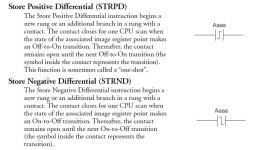Hi Bernie.
I was just using 200 as a "for-instance" example. But the transition-on is just the instruction type and can be addressed to any binary address (internal bit, input, etc).
I'm used to ONS one-shot instructions from PLC5 / CLX platforms.
If I had this:
200
--|^|--------(300)
then 300 would energize for one scan (unless it was a latch) on the rising-edge of 200.
What I am not sure of is if the OFF to ON transition of 200 has to be made and evaluated on consecutive scans.
In my first example, the transition of 200 occurs BEFORE the rest of the run is evaluated since 100 is still false. So when 100 finally does go High, 200 has already been High for more than one scan, so I'm not sure if the one-shot is then evaluated or only if the opportunity has passed.
On PLC5 / CLX it is easier to tell because the ONS instruction is not tied to the condition of a bit, but to whether or not the preceding logic is true or false.
Hopefully am not making this more convoluted than it has to be...
EDIT:
In the manual it mentions it mimics the operation of a momentary push button, but does not explicitly state what happens if the rung is still false when the transition occurs. If it truely is mimicking a pushbutton then I would think that the rung would have to be true prior to the transition.



